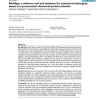Free Online Productivity Tools
i2Speak
i2Symbol
i2OCR
iTex2Img
iWeb2Print
iWeb2Shot
i2Type
iPdf2Split
iPdf2Merge
i2Bopomofo
i2Arabic
i2Style
i2Image
i2PDF
iLatex2Rtf
Sci2ools
BMCBI
2006
2006
RibAlign: a software tool and database for eubacterial phylogeny based on concatenated ribosomal protein subunits
Background: Until today, analysis of 16S ribosomal RNA (rRNA) sequences has been the de-facto gold standard for the assessment of phylogenetic relationships among prokaryotes. However, the branching order of the individual phlya is not well-resolved in 16S rRNA-based trees. In search of an improvement, new phylogenetic methods have been developed alongside with the growing availability of complete genome sequences. Unfortunately, only a few genes in prokaryotic genomes qualify as universal phylogenetic markers and almost all of them have a lower information content than the 16S rRNA gene. Therefore, emphasis has been placed on methods that are based on multiple genes or even entire genomes. The concatenation of ribosomal protein sequences is one method which has been ascribed an improved resolution. Since there is neither a comprehensive database for ribosomal protein sequences nor a tool that assists in sequence retrieval and generation of respective input files for phylogenetic reco...
| Added | 10 Dec 2010 |
| Updated | 10 Dec 2010 |
| Type | Journal |
| Year | 2006 |
| Where | BMCBI |
| Authors | Hanno Teeling, Frank Oliver Glöckner |
Comments (0)

